Vortragende: Cornelia Reiher (Freie Universität Berlin, Professorin für Japanologie)
Veranstaltung: 5. INTERNATIONALE WOCHE DER SEMIOTIK: FOOD FOR THOUGHT
Universität Potsdam
Ort: BILDUNGSFORUM Potsdam
Datum: 23.01.2024
Zeit: 10:15 – 11:15
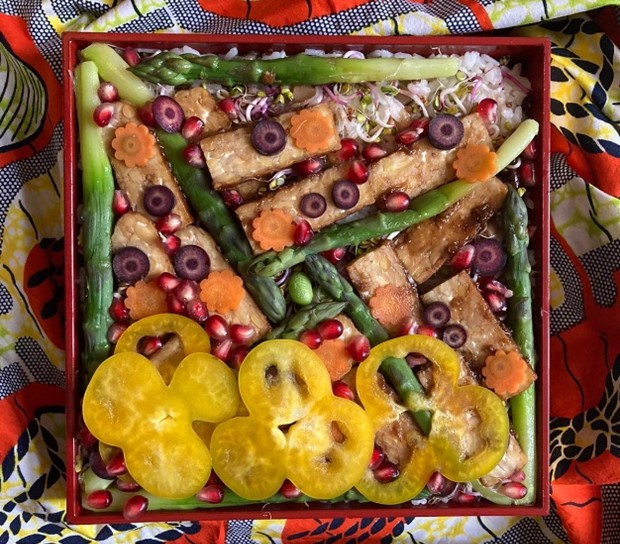
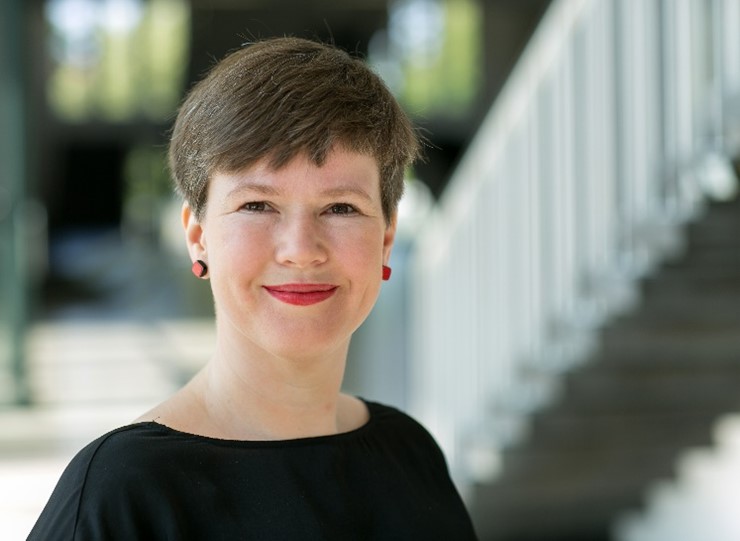

Vortragende: Cornelia Reiher (Freie Universität Berlin, Professorin für Japanologie)
Veranstaltung: 5. INTERNATIONALE WOCHE DER SEMIOTIK: FOOD FOR THOUGHT
Universität Potsdam
Ort: BILDUNGSFORUM Potsdam
Datum: 23.01.2024
Zeit: 10:15 – 11:15


by Cornelia Reiher
When I talk to Japanese migrants in Berlin, they usually say that they miss Japanese food. Although there are many Japanese restaurants in the city, it is too expensive to eat there every day. Most of my research participants only go out to eat in Japanese restaurants on special occasions. Some take sashimi and other dishes to eat at home, while others never eat at Japanese restaurants. Therefore, in this post, I introduce the everyday eating practices of Japanese migrants in Berlin and where they buy the necessary ingredients to prepare them at home. In 2018, one of our student projects investigated how Japanese exchange students use Asian supermarkets in Berlin. However, Japanese migrants who live in Berlin long-term use many other options besides Asian supermarkets to buy ingredients for Japanese cuisine on a daily basis.
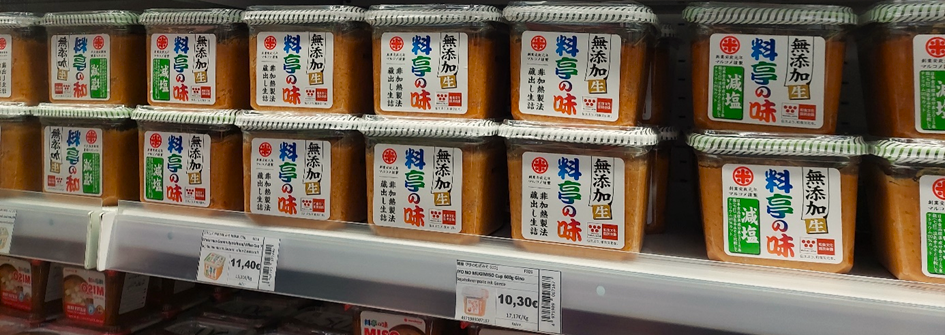
Most of the migrants I have interviewed over the years have told me that they cook Japanese food at home or prepare fusion dishes such as pasta with soy sauce. Some prepare rice and miso soup every day. One research participant told me that onigiri is her soul food, and when Japanese migrants get together, they bring rice-based dishes such as maki sushi. Rice came up in almost all the interviews and conversations I had, and many Japanese migrants mentioned that they bring rice home from a trip to Japan, ask their relatives to send it, or buy yumenishiki rice in Asian supermarkets, even though it is very expensive. Japanese migrants who have lived in Berlin for more than a decade emphasize that it is much easier to buy Japanese ingredients today than it was twenty years ago. The number of Asian supermarkets and online delivery services has increased. Some Japanese foods such as soy sauce or sake are now even available in normal supermarkets. A new Japanese supermarket offering products from Japan has recently opened in Berlin. It offers sake, spices, fresh vegetables and mushrooms, curry pastes, sweets, noodles and more. The supermarket even sells ready meals, just like in Japanese supermarkets, including sashimi and sushi, as well as yakitori, bentō and onigiri. The dishes are freshly prepared in a small kitchen in the store.
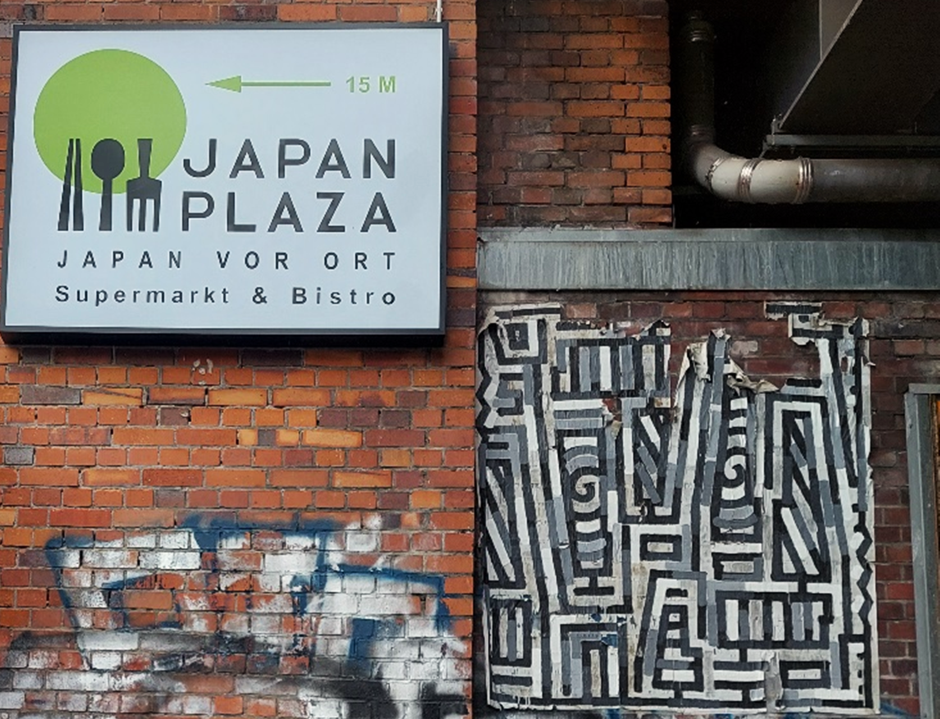
In addition to supermarkets, online delivery services provide the Japanese population with frozen fish and other ingredients they need to cook at home. To save some money on delivery costs and because deliveries are often made during the day when most people are at work, some migrants take turns to take orders for their friends in a group order. Sometimes companies that supply fresh ingredients to the Japanese migrant community across Europe organize pop-up events in cities with a larger Japanese community. On these occasions, many migrants come together and enjoy the opportunity to see and choose the products firsthand, meet other people and chat over a hot miso soup. These events are tailored to Japanese customers, the staff speak Japanese, and the information on the price tags is written in Japanese.
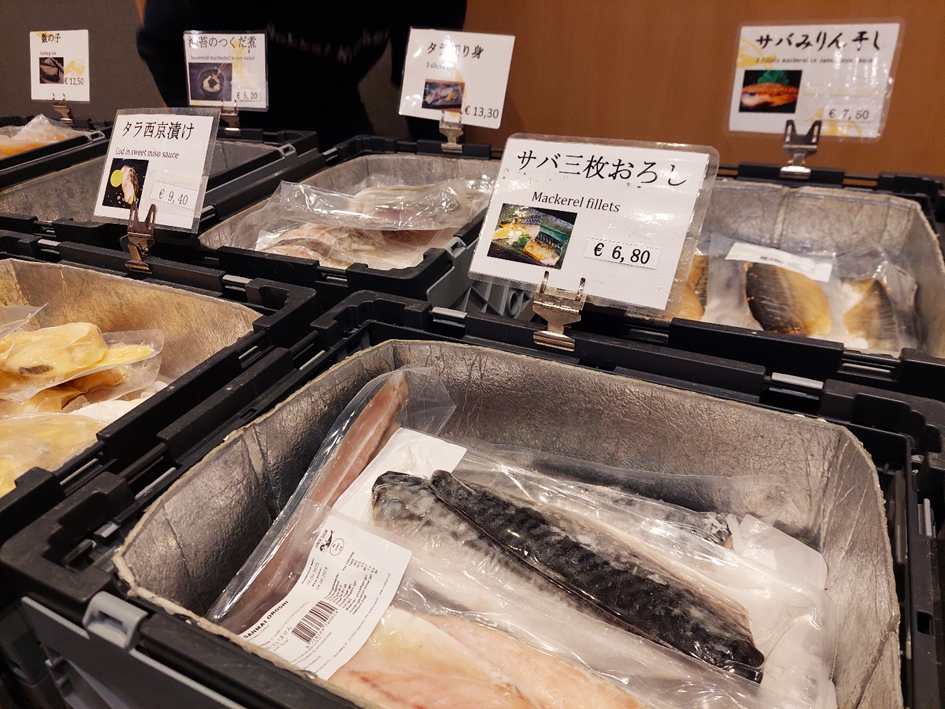
Overall, the growing number of places where Japanese food and ingredients can be consumed shows how a culinary infrastructure has developed with the growing Japanese diaspora in Europe. Although more Japanese ingredients are available in Berlin, most migrants emphasize that they are still expensive. Therefore, many migrants make their own miso or nattō at home because they either can’t afford to buy ready-made products or don’t want to spend so much money on them. And some simply enjoy making it themselves. Of course, this is only possible because ingredients such as kōji are now available in Berlin or can be ordered online. This brief overview of where Japanese migrants buy ingredients for home cooking in Berlin shows that the city’s Japanese foodscape consists not only of restaurants and wholesalers that supply restaurants with ingredients, but also of supermarkets and stores where Japanese migrants and the growing number of people interested in Japanese food meet their needs for preparing Japanese dishes at home.
by Cornelia Reiher
Japanese food is very popular in Berlin, and certain Japanese foods even have their own festivals. In October, I attended the opening of Sake Week and a rāmen festival. Since both events were held on the same day, it was a very exciting day full of interesting sights, delicious taste sensations and exciting encounters with people who are passionate about Japanese food and drink. According to their website, Sake Week is organized by the Sake Embassy, an organization that describes itself as a „liquid meditation movement“. The last Sake Week was held in 2022 in five cities with 50 events, while Sake Week 2023 featured 100 events in nine cities in Germany, Austria, Switzerland and Slovakia.

After we had climbed the stairs to the opening event at a brewery, we were greeted with a “Japanese Radler” made from beer, yuzu sake and lemonade. After a short welcome, we were able to participate in sake tastings from two import companies that offered sake from different prefectures in Japan. The audience that had gathered for the event included people from the restaurant and retail industries, Japanese cultural organizations and their friends and supporters. I met restaurant owners, chefs and sake sommeliers who told me how they pair dishes with sake. They all participate in Sake Week by hosting special sake-themed events at their restaurants and bars. One restaurateur told me that she likes sake because she finds that most of her customers are already attuned to wine and are more open with sake because they don’t know it as well yet. With sake pairings, she has more leeway and guests can make new discoveries.
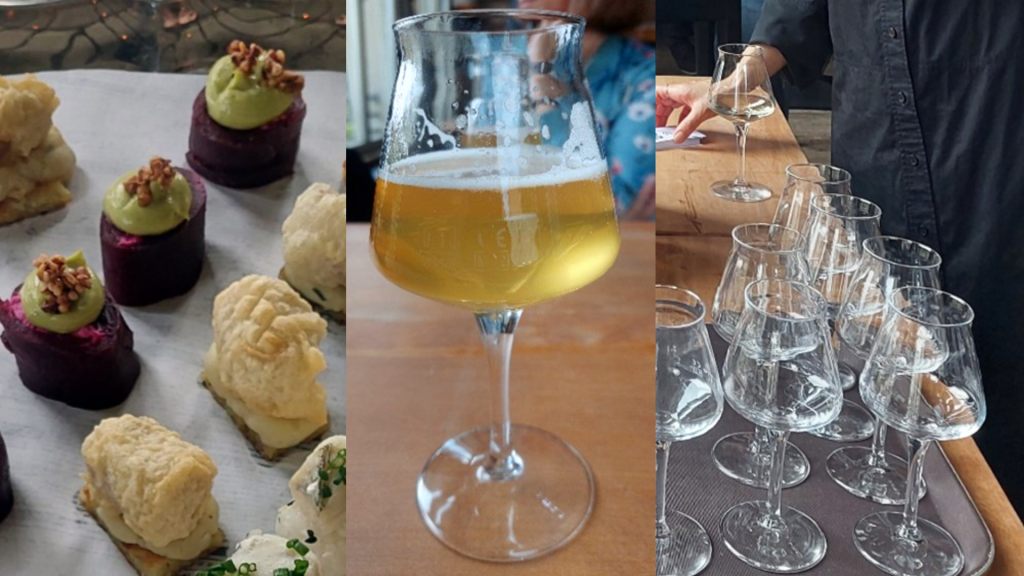
With different types of sake, fusion finger food and interesting conversations, the two hours went by way too fast and like the sake entrepreneurs who packed up their sake to travel to the rāmen festival, we had to head there too. However, on the way to the rāmen festival, it had started to rain and by the time we arrived, we were completely soaked. Despite the bad weather, there was a long line of people waiting to buy a ticket. Fortunately, we had purchased our tickets online and were able to walk right in. The event was designed as an outdoor event with various booths. When we arrived, people were crowding the few covered seats. Nevertheless, the atmosphere was good and most visitors enjoyed the Japanese food and drinks under the temporary rain shelters.

Since we were already wet, we looked around first. In addition to three stalls selling rāmen, there were other Japanese dishes such as takoyaki, taiyaki and okonomiyaki, a sake stall and a stall selling various Japanese handicrafts. One booth was set up in the style of Hakata Yatai. These food stalls are typical of street vendors in Fukuoka, a city in northern Kyushu. The food offered was appropriately tonkotsu rāmen, a specialty from this area also known as Hakata rāmen. The soup broth is based on pork bones and the dish is traditionally topped with sliced pork belly. We got in line and got a seat right by the cart.
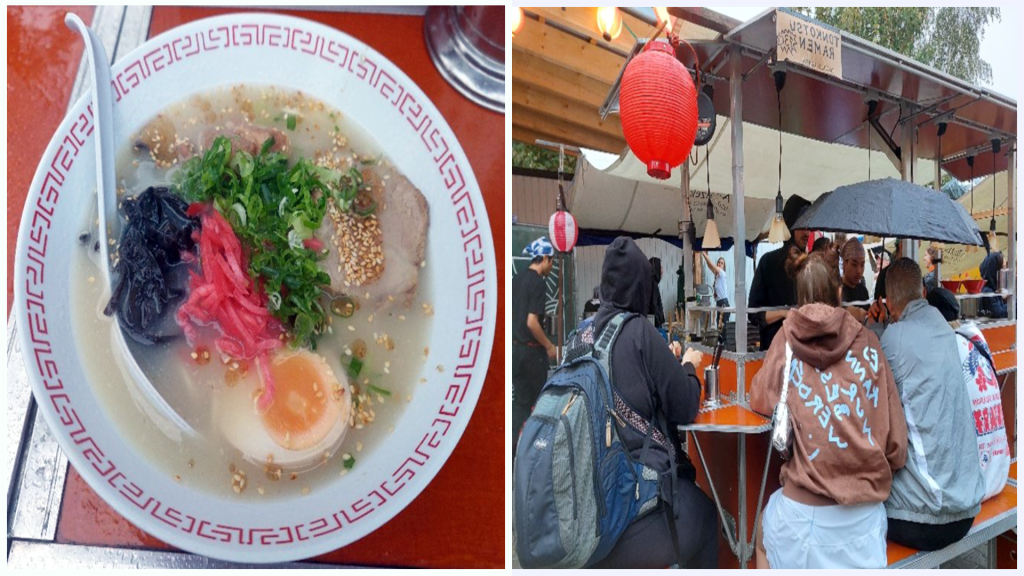
While we bravely took our seats outside, most of the guests ordered rāmen to go and ate it under one of the few canopies. We held the umbrella above us and although it was a challenge to hold the chopsticks in one hand and the umbrella in the other, the noodles tasted delicious. Maybe because I had never eaten ramen at a yatai in the rain before. Several young Japanese men and women were working at the stall. Two girls took orders and cashed up, while the other employees prepared the ingredients, cooked the soup and served it. We sat right in front of the containers of ingredients, like eggs and scallions, and I hope my umbrella did not drip into it.
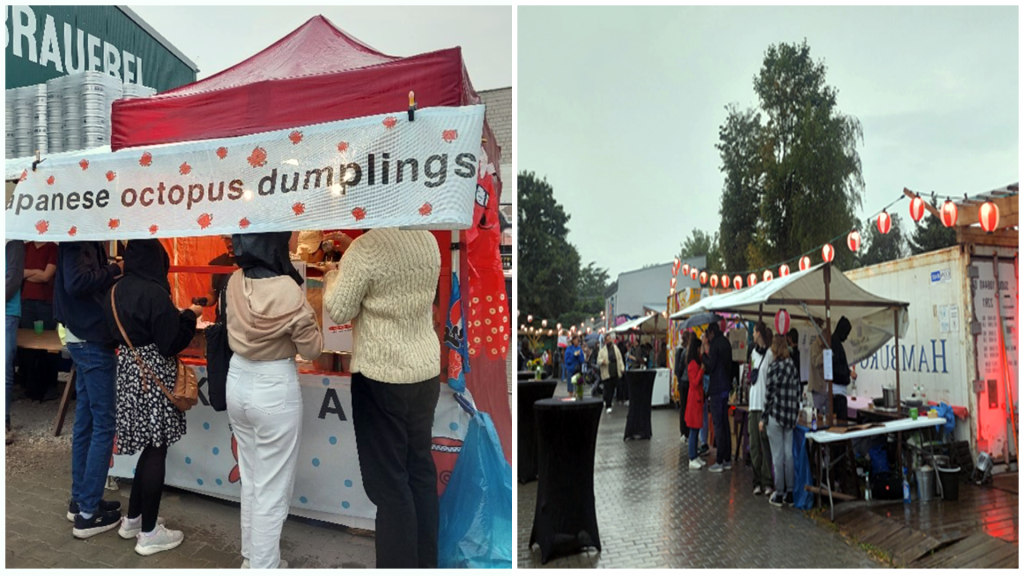
Later it cleared up and more people came to the festival area. But since we were still wet, we decided to look for a dessert and call it a day. We were lucky and bought the last vegan taiyaki with matcha cream and cherries and headed back to the next S-Bahn station, passing supermarkets, gas stations and car dealerships. It was an eventful day, and I was amazed at how many people from very different backgrounds are fascinated by Japanese food and have come just to eat rāmen and other Japanese dishes. At the same time, there is a growing number of non-Japanese entrepreneurs working to promote Japanese food and drink in Germany and I would like to learn more about what drives them.
Jonas John and Zihang Yu created a video on the certification of Japanese restaurants in Berlin.
Watch here and enjoy!
Our course in the summer semester was held in a hybrid format because one student was living in Tokyo. Vanessa and Olivia used this opportunity to compare rāmen in Tokyo and Berlin. They present their findings in a podcast. Please listen here (in German):

by Cornelia Reiher
Japanese food is sold in various places in Berlin. Some are only available temporarily like pop-up stores, others can be found regularly in the form of a stall at a market, sometimes you can only order food online, while still others take a permanent form of cafes or restaurants. Certain places are only open at a certain time of year, and sometimes they are very secretive, with no information about opening hours, and it is purely by chance that you pass by when they are open. Sometimes spaces with other functions like a movie theater are rented to serve Japanese food.

Takoyaki and onigiri sold at Japanese food stalls
Copyright © Cornelia Reiher 2023
Some of the food stalls have been around for many years at flea markets or market halls and are now a regular part of the city’s culinary landscape. It is interesting to note that many of these stalls are run by women. They are often a way to earn extra money while studying or working as an artist. Once or twice a week, for example, they sell takoyaki, onigiri, taiyaki and other Japanese street food. The investment in such a food stall is comparatively small and hardly any staff is needed. However, the food stalls have also had problems with the increased food prices in the last two years and have had to raise prices. The Corona pandemic also resulted in lost revenue as markets were unable to operate for many months. A takeaway strategy was largely impossible without a fixed kitchen and distribution infrastructure. By the summer of 2023, however, Japanese food stalls at markets and festivals were more popular than ever, with customers waiting in long lines.

A Japanese restaurant in a movie theater
Copyright © Cornelia Reiher 2023
Faced with rising rents for restaurant space, Japanese food entrepreneurs often try to find temporary solutions for their businesses, including pop-up stores or co-use of spaces such as movie theaters or galleries. Food pop-ups in Berlin can take the format of bars, offering only a few dishes and an extensive drink menu, but they can also offer lunch or appear as noodle restaurants or bakeries. Reusing temporarily vacant storefronts or public spaces or sharing spaces at lunchtime that are normally only open at night, is a win-win situation for the city, the owners of the spaces and Berlin’s Japanese foodscape. After a while, some of these pop-up stores became permanent establishments if they did well. In this sense, they can be seen as a kind of experimental field where food entrepreneurs can try out their concepts and menus at relatively low cost.

The window display of a Japanese pop-up store
Copyright © Cornelia Reiher 2023
Since the start of the sushi boom in Berlin in the 1990s, the Japanese foodscape in Berlin has lost none of its dynamism, not only in terms of the type of food served but also in terms of the places where Japanese food is sold. While some long-established restaurants have disappeared, new ones are popping up, and hopefully, many of them will stay.
by Zihang Yu
This semester we had the opportunity to learn techniques to systematically observe people, practices and environments and collect the data needed for our research. After class, we were able to put this into practice through hands-on exercises. I conducted observations in a Japanese restaurant and in the Japanese cafeteria at Freie Universität Berlin with two other students from the course. We decided to go to a Japanese restaurant on Kantstraße. The restaurant was decorated in Japanese style, with paintings and posters on the walls, showing ukiyo-e, samurai and Japanese beer. We also saw umbrellas made of bamboo in different colors, kabuki masks and red lanterns with the Japanese word sake on them. Soft and relaxing jazz music played in the background.

A Japanese set meal I enjoyed at one of the restaurants.
Copyright © Zihang Yu 2023
In the restaurant, all dishes were Japanese. I chose the dish saba shioyaki. The dish consisted of grilled mackerel, lemon and grated white radish. It was accompanied by white rice, miso soup, tsukemono and fruit. The overall taste was like in Japan. Unfortunately, I was seated in a small room inside the restaurant during this observation, so I could not observe the customers and staff seated outside.

Eating Japanese-style on zabuton in the Shokudō at FU Berlin
Copyright © Zihang Yu 2023
We also had the opportunity to observe the Shokudō Cafeteria at Freie Universität. This Japanese cafeteria also has many Japanese style decorations. There are bonsai, a painting of Mount Fuji on the wall and tatami mats in the cafeteria and try to give students a Japanese or Asian impression, the ingredients used, the way they are prepared, and the flavors are different from Japan.

The meal I had in the Japanese cafeteria
Copyright © Zihang Yu 2023
Overall, I really enjoyed this observation exercise. During my observation, I mainly focused on the interior style of the restaurant and the taste of the food. This gave me interesting insights into the variations of food and interior design. I am glad that we could put into practice the methodical knowledge we learned in class in a relaxed way with our classmates outside the classroom.
* Zihang Yu is studying in the Master’s program in Japanese Studies at Freie Universität Berlin.
by Jonas John
On June 20, 2023, I went together with the other course participants and another friend to Kantstraße to look at three different Japanese restaurants and eat at one of them. I will now briefly introduce them. Our first stop was Udagawa, one of the oldest still existing Japanese restaurants in Berlin. I had been there the week before, so I already knew one of the dishes and wanted to eat there again. Although there were several small benches outside, we decided to sit in the back of the restaurant because it was really hot and there were fans. The decor reminded me of Japanese family restaurants. The whole room is wood style, and there are ukiyo-e pictures and beer signs on the walls that look like they came from the 1950s. There are also various Japanese flags, small miniature umbrellas, lanterns, and a door that leads directly to the kitchen in the back. But there is another small kitchen in the front where small dishes are prepared by a cook and two waitresses. Light string jazz was playing in the background, creating a relaxed atmosphere.
When we arrived there at 18:30, there were only three guests present besides us. However, that changed at 7:30 p.m. – by then there were already 12 guests. That seemed like a lot of people for a Tuesday night, after all, the room was packed. The food tastes like in Japan and also surprisingly cheap compared to other Japanese restaurants in Berlin; only between 7 and 16 euros for a whole menu! There are mostly „typical“ Japanese dishes offered. The only exception are the spring rolls. When asked what the waitress would recommend and what most diners would go for, we were recommended katsukarē with slaw, but we opted for something else. There is also a large selection of vegetarian dishes, one would also find in Japan. The visit to Udagawa was a pleasant experience that we all enjoyed!

A set meal in a Japanese restaurant in Berlin
Copyright © Jonas John 2023
Then we went to Heno Heno. Heno Heno is a small store near Udagawa. When we got there around 7:45pm, we saw four people sitting outside on small chairs eating. In front of the restaurant is a large doll that looks like a mascot. There were also two people dining inside. Behind the counter in the dining area, we could look right over the shoulder of the male chefs while the female waitresses took orders. Among the dishes offered, gyūdon and karē are most popular at Heno Heno.

Taking notes during fieldwork in a Japanese restaurant
Copyright © Jonas John 2023
We last visited the Kushinoya. This kushiage restaurant also has an outdoor dining area, but it was completely empty. Inside, however, there were many people, so I assume it is very popular. There were two signs in front of the front door. One had the menu on it, so you could see that it was a slightly more expensive restaurant. Next to it was a sign advertising a sparkling sake and informing customers that edamame go with it for free. The windows, through which it was already very difficult to see, were also covered with stickers of various certificates. This also seemed to indicate that this was more of a fine dining restaurant. We decided to come back another time with more money and ended our trip.
* Jonas John is a student in the master’s program in Japanese Studies at Freie Universität Berlin.
von Olivia Kühnemann
Im Rahmen des Seminars Methoden und Arbeitstechniken der Sozialwissenschaften der Japanologie führten wir teilnehmende Beobachtungen in einem japanischen Restaurant auf der Kantstraße durch. Meine letzte Japanreise war noch nicht lange her und ich sehnte mich nach dem Genuss japanischer Küche. Es war für mich außerdem der erste Besuch in diesem Lokal und so betrat ich neugierig und erwartungsvoll gemeinsam mit meinen beiden Kommilitonen das Restaurant. Schon beim Betreten wehte uns eine angenehme kühle Brise einer Klimaanlage entgegen, die an diesem heißen Sommertag äußerst willkommen war. Die japanische Einrichtung fiel mir direkt ins Auge: viele Holzelemente, japanische ukiyo-e und die gedämpfte Beleuchtung schufen eine ruhige und einladende Stimmung. Gemeinsam mit meinen Kommilitonen fanden wir uns an einem Tisch im hinteren Bereich des Restaurants wieder und legten unsere Notizbücher auf dem Tisch ab. In Ruhe betrachteten wir die Einrichtung des Etablissements und blätterten das lange Menü durch. Das Speiseangebot war sehr vielfältig, u.a. wurden sashimi, sushi, rāmen, teishoku, karaage, gyōza, udon und vereinzelte vegetarische Gerichte angeboten. Wir bestellten alle drei unterschiedliche Gerichte.

Exkursion in ein japanisches Restaurant auf der Kantstraße
Copyright © Olivia Kühnemann 2023
Ich entschied mich für ein vegetarisches Gericht. Während wir auf das Essen warteten, hatten wir genügend Zeit das Geschehen zu beobachten. Wie auch der Eingangsbereich des Restaurants war auch der hinterer Raum mit zahlreichen japanischen Bildern und Elementen dekoriert. Neben den anfangs erwähnten ukiyo-e fanden sich hier auch ein japanischer Schirm und eine Nō-Theater- Maske. Mir fiel die leise angenehme Jazz Musik auf, die im Hintergrund lief. Die Interaktionen zwischen dem Personal waren aufgrund unserer Platzwahl im hinteren Bereich des Restaurants nur schlecht zu beobachten. Meine Kommilitonen und ich machten uns eifrig Notizen. Zwischendurch konnten wir die Bedienung beobachten, die von unserem Handeln ein wenig irritiert zu sein schien. Vermutlich hielt sie uns für Restaurant-Kritiker.
Nach einiger Zeit wurde unser Essen serviert. Mein kushikatsu bentō wurde auf einem Tablett in unterschiedlichen Schüsseln und Behältern präsentiert. Das frittierte Gemüse war in einer Kammer einer viereckigen Box. In den beiden anderen Kammern waren Salat und eingelegtes Gemüse. Zusätzlich gab es eine Schale mit Miso-Suppe und eine Schale mit weißem Reis. Während wir aßen, erschienen weitere Kunden, darunter eine größere Gruppe, die sich an einen Tisch gegenüber von uns setzten. Neben dieser Gruppe saßen im hinteren Bereich zwei Paare, die jeweils Sushi und Bentō Boxen aßen.
Im Vergleich zu einer Beobachtung allein, erregten wir als Gruppe deutlich mehr Aufmerksamkeit, so dass wir von der Bedienung ein wenig mit Skepsis wahrgenommen wurden. Jedoch hatten wir auf diese Möglichkeiten und auszutauschen und auf verschiedene Dinge aufmerksam zu machen. Die teilnehmende Beobachtung in der Rolle des Gastes bereitete mit großer Freude und ich bin sehr dankbar für diese Erfahrung. Ich bin bereits gespannt auf die nächste Beobachtung im Rahmen des Abschlussprojekts.
*Olivia Kühnemann studiert im Masterstudiengang Japanologie an der Freien Universität Berlin.
by Cornelia Reiher
On a hot Friday afternoon in June, we visited a restaurant run by a Japanese chef. When we arrived, the outdoor area in front of the restaurant was full of people enjoying a late lunch. We took a seat inside, and while Machiko, the chef, was still busy preparing the food, we had the opportunity to look around and check out the menu. Located in a movie theater, Machiko offers lunch on weekdays, but serves not only Japanese dishes such as sakedon, sushi or udon, but also bibimpap. Except for the sakedon, all dishes are vegan or have a vegan option.

When things quieted down, Machiko sat down with us and we began with the interview. We had successfully established an Internet connection so that one of the students could join in from Tokyo. The students had prepared questions for Machiko in Japanese and were a bit nervous in advance. The interview focused on Machiko’s migration experience, her professional background and her idea of Japanese food, her customers, ingredients and experiences during the Covid pandemic. We learned that she was trained as a chef in Japan and mainly prepared kaiseki ryōri back then. She really likes fusion cuisine as long as it respects Japanese cuisine. She is convinced that her training allows her to prepare the dishes she now offers. For the lunch she serves, the most important criteria are that it can be served quickly, tastes delicious and is reasonably priced.

The conversation was very interesting and went well. Machiko’s positive attitude and charisma was very motivating and reassuring, so small difficulties with the Japanese language were no problem. After the interview, we ordered a few more dishes to reward ourselves before the kitchen closed. During the hour we spent inside for the interview, most of the guests had already left and the staff had already started cleaning up. Visiting the restaurant instead of conducting the interview online or at the university was not only convenient for Machiko, but also provided us with a lot of insight by being able to see the restaurant, experience the atmosphere and most importantly, eat the dishes offered. Thank you, Machiko, for your time!
